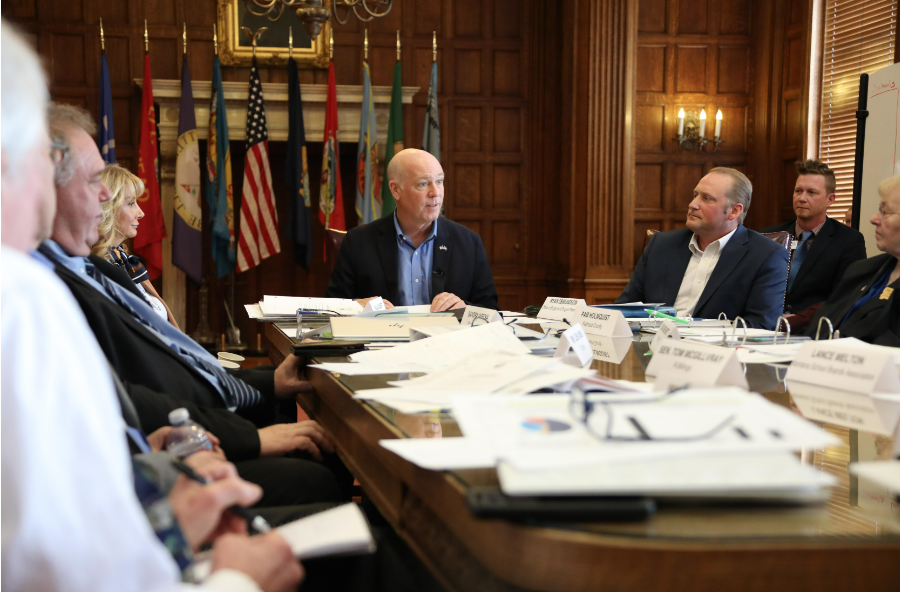HELENA, Mont. – Governor Greg Gianforte today convened the first meeting of his Property Tax Task Force at the State Capitol in Helena.
“As we, and all Montanans, know too well, property taxes are too high,” Gov. Gianforte said to task force members at their first meeting. “Montana homeowners need and deserve relief. That’s why we’re here today – to develop a plan to reform our property tax system and bring relief to Montana homeowners. They’re counting on us to get it done, and we must deliver.”
Established in January through Executive Order 1-2024, Gov. Gianforte charged the task force with providing him “with recommendations and strategies for the State of Montana…to reform the property tax system and reduce the burden of property taxes on taxpayers.”
The diverse, bipartisan task force includes members who are Republican and Democratic legislators, local officials, state agency leaders, critical stakeholders, economists, researchers, and experts. Ryan Osmundson, the governor’s director of Budget and Program Planning, serves as chair of the task force.
“Property taxes are a complex issue, but I am optimistic about what this group will accomplish as we work to identify the underlying problems and provide solutions for long-term reforms to our property tax system,” Osmundson said.
While the task force may recommend any strategy to reform the property tax system, the governor expressly asked the task force to provide recommendations that:
- arrest the rate of growth of property taxes, including assessments and fees, as well as alleviate the impact of drastic increases of property reappraisals;
- increase transparency of property tax bills, make them easier to understand for property taxpayers, and improve customer service in the payment schedules for property taxpayers;
- increase transparency of and public engagement in public budgeting;
- increase public participation for mill levy ballot measures;
- ensure property taxes paid by Montana resident homeowners and on Montana long-term rentals reflect well on supporting homeownership and workforce housing;
- ensure each Montana child has access to a quality education; and
- ensure lower-income Montana homeowners, Montana homeowners who are on a fixed income, and disabled Montana veterans or their surviving spouse are not at risk of losing their home because of property taxes.
At today’s task force meeting, Gov. Gianforte reaffirmed that charge and emphasized, “We must do all of this without imposing a statewide sales tax. Period.”
Largely a function of local jurisdictions, property taxes fund local government services, with approximately 85% of property tax revenue from residential homeowners going directly to local jurisdictions and the remaining 15% going to the State of Montana which returns the amount in full to help fund K-12 public schools throughout the state.
Gov. Gianforte said, “Most local governments, including counties, are good stewards of taxpayer resources, live within their means, and exercise restraint with property tax increases. In fact, Flathead County is a great example of fiscal responsibility. That’s one reason I’m proud Commissioner Pam Holmquist is on this task force and here today. Between fiscal year 2023 and fiscal year 2024, Flathead County cut – yes, cut – its spending by more than 2 percent.”
Gov. Gianforte, however, cautioned, “There are some counties that are spending out of control. Between 2001 and 2022, inflation grew each year by an average of about 2.4%. But the average property tax growth rate for both counties and cities was over 6%. Ultimately, we need long-term reforms to rein in property taxes.”
According to the nonpartisan Legislative Fiscal Division, between 2001 and 2022, inflation grew at an average annual rate of 2.42%, while between tax years 2001 and 2022, the annual average property tax growth rate for counties was 6.19%, cities 6.13%, local schools 4.40%, and countywide schools 3.60%.
To reduce the burden of property taxes for Montanans, the governor in June 2023 delivered Montanans $120 million in permanent, long-term property tax relief through House Bill 587. Further, the governor secured up to $1,350 in property tax rebates for Montana homeowners for their primary residence over 2023 and 2024. Taken together, the measures provide the average Montana homeowner with relief that more than offsets his or her property tax increase.
The governor also boosted property tax relief for Montanans with low or fixed incomes, as well as disabled veterans or their unmarried surviving spouses. To further reduce the burden of property taxes, the governor reformed the property tax system to allow homeowners to pay their property taxes in seven equal installments throughout the year, rather than only in the months of November and May.
More information about the task force may be found at propertytaxreform.mt.gov.





